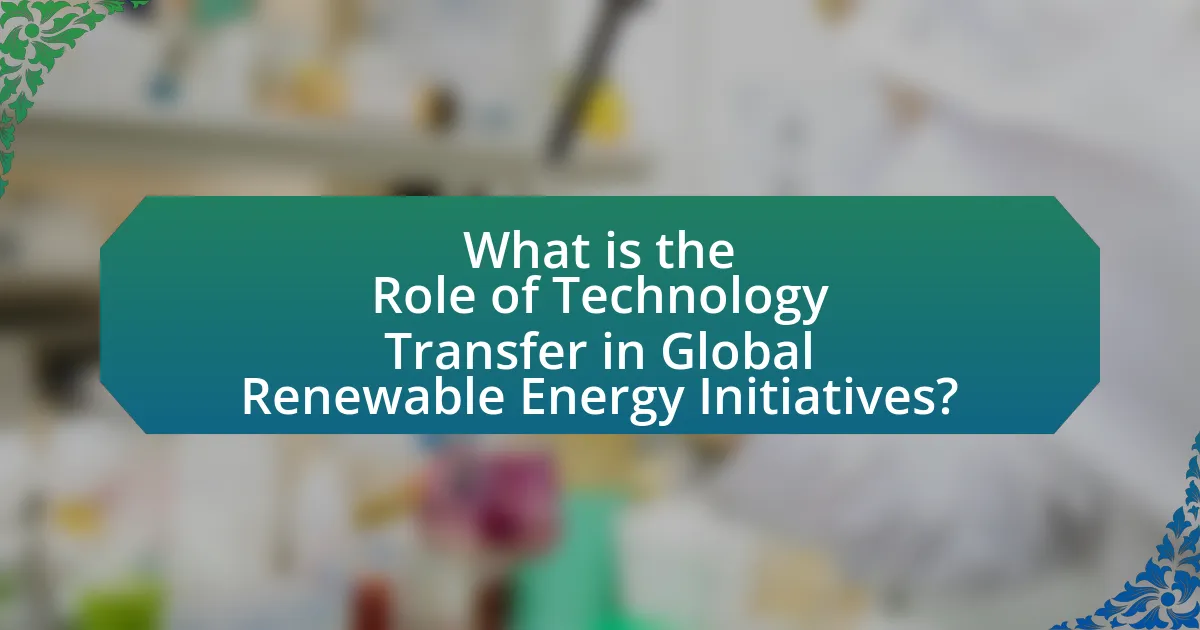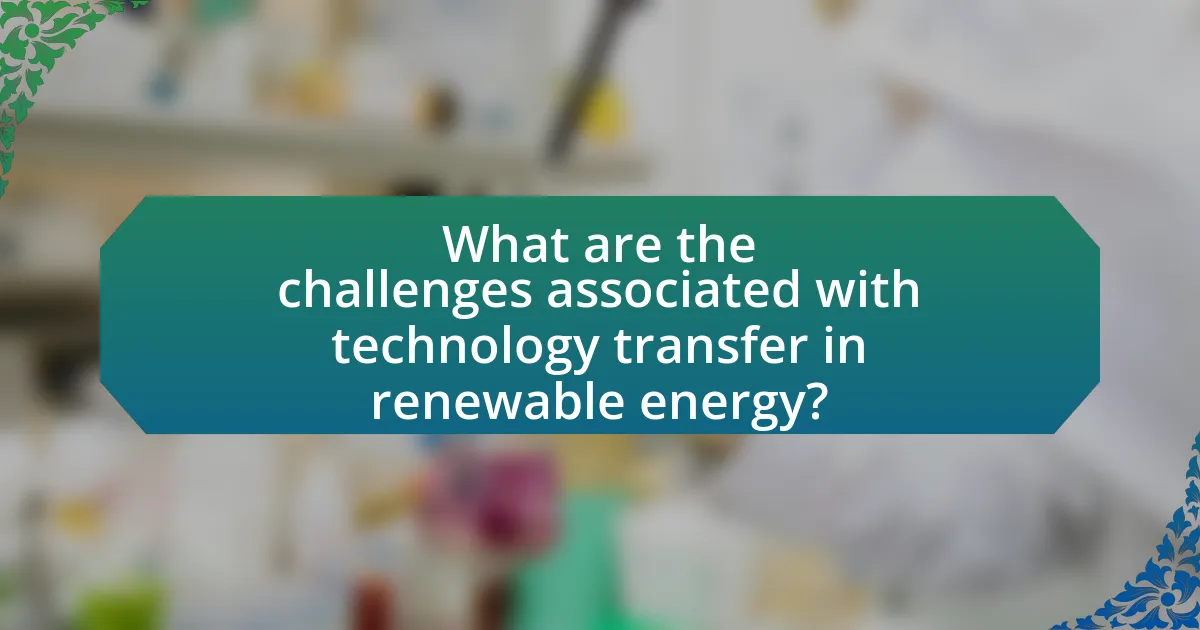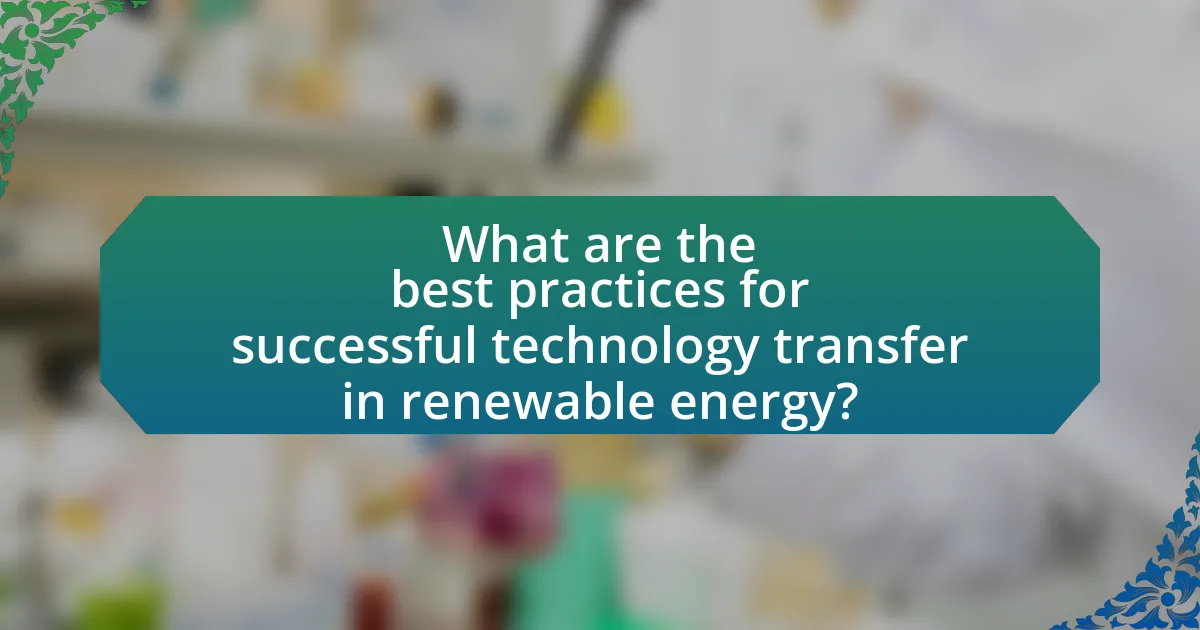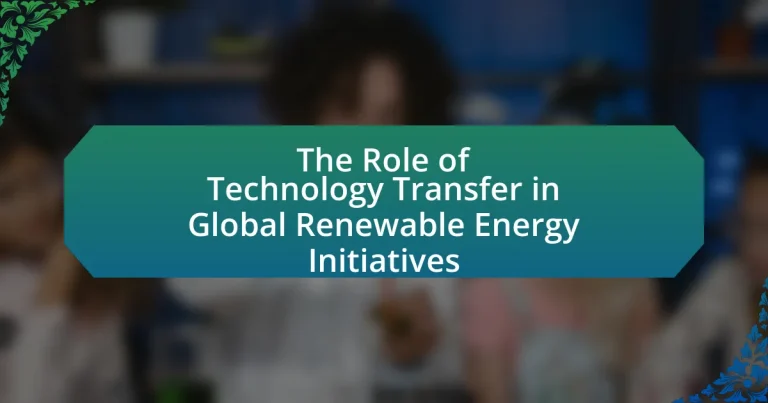Technology transfer is a vital component of global renewable energy initiatives, enabling the exchange of innovative technologies and practices across borders. This process is particularly beneficial for developing countries, allowing them to access advanced renewable energy solutions that facilitate their transition to sustainable energy systems. The article explores how technology transfer enhances renewable energy development, the key processes involved, and the roles of various stakeholders, including governments, private companies, and international organizations. It also addresses the challenges and barriers to effective technology transfer, such as high costs and intellectual property concerns, while highlighting successful case studies and best practices that can inform future initiatives.

What is the Role of Technology Transfer in Global Renewable Energy Initiatives?
Technology transfer plays a crucial role in global renewable energy initiatives by facilitating the sharing of innovative technologies and practices across borders. This process enables developing countries to access advanced renewable energy solutions, which can accelerate their transition to sustainable energy systems. For instance, the International Renewable Energy Agency (IRENA) reported that technology transfer can enhance the capacity of nations to implement renewable energy projects, leading to increased energy efficiency and reduced greenhouse gas emissions. Furthermore, successful technology transfer initiatives, such as the deployment of solar photovoltaic systems in Africa, demonstrate how collaboration between developed and developing nations can drive significant advancements in renewable energy adoption.
How does technology transfer facilitate renewable energy development?
Technology transfer facilitates renewable energy development by enabling the sharing of innovative technologies, expertise, and best practices across borders. This process accelerates the adoption of renewable energy solutions, as countries can leverage existing advancements rather than starting from scratch. For instance, the International Renewable Energy Agency (IRENA) reports that technology transfer has led to significant cost reductions in solar and wind energy, with global solar photovoltaic costs dropping by 82% between 2010 and 2019 due to shared innovations. Such collaboration enhances local capacities, promotes sustainable practices, and ultimately contributes to achieving global climate goals.
What are the key processes involved in technology transfer?
The key processes involved in technology transfer include identification, assessment, adaptation, and dissemination of technology. Identification involves recognizing the technology that can be transferred, while assessment evaluates its feasibility and potential impact. Adaptation modifies the technology to fit the local context, ensuring it meets specific needs and conditions. Dissemination involves sharing the technology with stakeholders, which can include training, licensing, and establishing partnerships. These processes are critical in facilitating the effective transfer of renewable energy technologies, as evidenced by initiatives like the United Nations Framework Convention on Climate Change, which emphasizes the importance of technology transfer in achieving global sustainability goals.
How do different stakeholders contribute to technology transfer?
Different stakeholders contribute to technology transfer by facilitating collaboration, funding, and knowledge sharing. Governments create policies and incentives that encourage investment in renewable energy technologies, while private companies develop and commercialize these innovations. Research institutions provide essential data and expertise, often collaborating with industry to ensure that technologies are viable and effective. Non-governmental organizations advocate for sustainable practices and help bridge gaps between communities and technology providers. According to the International Renewable Energy Agency, effective technology transfer can lead to a 30% reduction in costs for renewable energy projects, highlighting the critical role of these stakeholders in advancing global renewable energy initiatives.
Why is technology transfer crucial for global renewable energy initiatives?
Technology transfer is crucial for global renewable energy initiatives because it facilitates the sharing of innovative technologies and best practices across borders, enabling countries to adopt and implement renewable energy solutions more effectively. This process accelerates the deployment of clean energy technologies, such as solar and wind power, which are essential for reducing greenhouse gas emissions and combating climate change. For instance, the International Renewable Energy Agency (IRENA) reported that technology transfer can significantly lower the costs of renewable energy projects, making them more accessible to developing nations. By fostering collaboration and knowledge exchange, technology transfer enhances the capacity of countries to transition to sustainable energy systems, ultimately contributing to global energy security and environmental sustainability.
What impact does technology transfer have on energy access in developing countries?
Technology transfer significantly enhances energy access in developing countries by facilitating the adoption of advanced renewable energy technologies. This process allows these nations to overcome barriers such as high initial costs and lack of technical expertise. For instance, the deployment of solar photovoltaic systems has increased energy access for millions in regions like Sub-Saharan Africa, where traditional energy infrastructure is lacking. According to the International Renewable Energy Agency (IRENA), countries that engaged in technology transfer initiatives saw a 30% increase in renewable energy capacity from 2010 to 2020, demonstrating the direct correlation between technology transfer and improved energy access.
How does technology transfer enhance innovation in renewable energy sectors?
Technology transfer enhances innovation in renewable energy sectors by facilitating the exchange of knowledge, skills, and technologies between entities, which accelerates the development and deployment of advanced renewable energy solutions. For instance, the transfer of solar panel technology from developed countries to emerging markets has led to significant reductions in production costs and increased accessibility, evidenced by a 90% decrease in solar photovoltaic prices from 2009 to 2019. This exchange not only fosters local innovation but also stimulates economic growth and job creation in the renewable energy sector, as seen in countries like India, where technology transfer initiatives have led to the establishment of a robust solar manufacturing industry.

What are the challenges associated with technology transfer in renewable energy?
The challenges associated with technology transfer in renewable energy include high costs, lack of infrastructure, and intellectual property concerns. High costs can deter investment in new technologies, as initial capital is often required for development and deployment. Lack of infrastructure, particularly in developing countries, hampers the effective implementation of renewable technologies, making it difficult to integrate them into existing energy systems. Intellectual property concerns create barriers, as companies may be reluctant to share proprietary technologies due to fears of losing competitive advantage. These challenges hinder the widespread adoption of renewable energy solutions, impacting global efforts to transition to sustainable energy sources.
What barriers hinder effective technology transfer?
Barriers that hinder effective technology transfer include inadequate infrastructure, lack of financial resources, and insufficient human capital. Inadequate infrastructure, such as poor transportation and communication systems, limits the ability to disseminate technology effectively. Lack of financial resources restricts investments necessary for research, development, and implementation of new technologies. Insufficient human capital, characterized by a shortage of skilled personnel, impedes the ability to adopt and adapt technologies. According to a report by the United Nations Environment Programme, these barriers significantly affect the pace and success of technology transfer in renewable energy initiatives globally.
How do regulatory frameworks affect technology transfer?
Regulatory frameworks significantly influence technology transfer by establishing the legal and operational environment in which technologies are shared and adopted. These frameworks can either facilitate or hinder the movement of technology across borders, depending on their design and implementation. For instance, countries with supportive intellectual property laws and streamlined import/export regulations tend to experience higher rates of technology transfer, as evidenced by the World Bank’s report on technology diffusion, which highlights that nations with robust regulatory systems attract more foreign direct investment in renewable energy technologies. Conversely, stringent regulations or lack of clarity can create barriers, discouraging innovation and collaboration, as seen in regions with restrictive licensing requirements that limit the ability of companies to share and adapt technologies effectively.
What role does intellectual property play in technology transfer challenges?
Intellectual property (IP) plays a critical role in technology transfer challenges by influencing the accessibility and commercialization of innovations. IP rights can create barriers to technology transfer by restricting the sharing of knowledge and technologies, as companies may be reluctant to license their patented technologies due to concerns over competition and loss of market advantage. For instance, a study by the World Intellectual Property Organization (WIPO) highlights that stringent IP protections can hinder the diffusion of renewable energy technologies, particularly in developing countries, where access to such innovations is essential for sustainable development. This dynamic illustrates how IP can both incentivize innovation and simultaneously complicate the transfer of technology necessary for global renewable energy initiatives.
How can these challenges be overcome?
Challenges in technology transfer for global renewable energy initiatives can be overcome through enhanced collaboration between developed and developing nations. This collaboration can be facilitated by establishing international partnerships that focus on knowledge sharing, capacity building, and financial support. For instance, the United Nations Framework Convention on Climate Change (UNFCCC) emphasizes the importance of technology transfer as a means to support developing countries in achieving their renewable energy goals. Additionally, creating favorable policies and regulatory frameworks can incentivize private sector investment in renewable technologies, as evidenced by the success of feed-in tariffs in countries like Germany, which have significantly increased renewable energy adoption.
What strategies can enhance collaboration between developed and developing nations?
Enhancing collaboration between developed and developing nations can be achieved through technology transfer initiatives, capacity building, and joint research projects. Technology transfer allows developing nations to access advanced renewable energy technologies, which can significantly improve their energy infrastructure and sustainability. For instance, the United Nations Framework Convention on Climate Change emphasizes the importance of technology transfer in achieving climate goals, highlighting that developed nations have a responsibility to share their innovations with developing countries. Capacity building programs, such as training and education in renewable energy technologies, empower local communities and foster self-sufficiency. Joint research projects, exemplified by partnerships like the International Solar Alliance, facilitate knowledge sharing and innovation, leading to tailored solutions that address specific regional challenges. These strategies collectively create a framework for sustainable development and mutual benefit.
How can capacity building improve technology transfer outcomes?
Capacity building can significantly improve technology transfer outcomes by enhancing the skills, knowledge, and resources of individuals and organizations involved in the process. When stakeholders are equipped with the necessary expertise, they can better adapt, implement, and sustain new technologies, leading to more effective integration into local contexts. For instance, a study by the United Nations Development Programme highlights that countries with robust capacity-building initiatives experience a 30% increase in successful technology adoption rates compared to those without such programs. This correlation underscores the importance of investing in human capital and institutional frameworks to facilitate smoother technology transfer and ultimately drive progress in renewable energy initiatives.

What are the best practices for successful technology transfer in renewable energy?
Successful technology transfer in renewable energy requires collaboration between stakeholders, clear communication, and adaptation to local contexts. Engaging governments, private sectors, and research institutions fosters a supportive ecosystem for innovation. For instance, the International Renewable Energy Agency (IRENA) emphasizes the importance of building local capacities and providing training to ensure that technologies are effectively implemented and maintained. Additionally, establishing intellectual property frameworks can protect innovations while encouraging knowledge sharing. A study by the United Nations Environment Programme (UNEP) highlights that countries with strong policy frameworks and incentives for renewable energy adoption experience higher rates of successful technology transfer.
What models exist for effective technology transfer?
Several models exist for effective technology transfer, including the Linear Model, the Interactive Model, and the Network Model. The Linear Model suggests a straightforward progression from research and development to commercialization, emphasizing a unidirectional flow of technology. The Interactive Model, on the other hand, highlights the importance of feedback loops and interactions among stakeholders, facilitating a more dynamic exchange of knowledge. Lastly, the Network Model focuses on the collaborative relationships among various entities, such as universities, industries, and governments, to enhance technology diffusion. These models are supported by empirical studies, such as the work by Gibbons et al. (1994) in “The New Production of Knowledge,” which illustrates the significance of interactive processes in innovation.
How can public-private partnerships facilitate technology transfer?
Public-private partnerships (PPPs) facilitate technology transfer by leveraging the strengths of both sectors to enhance innovation and deployment of renewable energy technologies. These collaborations enable the sharing of resources, expertise, and risk, which accelerates the development and commercialization of new technologies. For instance, a study by the International Renewable Energy Agency (IRENA) highlights that PPPs can reduce the time and cost associated with bringing new technologies to market by combining public sector funding with private sector efficiency and innovation capabilities. This synergy not only fosters a conducive environment for research and development but also ensures that successful technologies are effectively disseminated and adopted across different regions, thereby promoting sustainable energy solutions globally.
What role do international organizations play in promoting technology transfer?
International organizations play a crucial role in promoting technology transfer by facilitating collaboration, providing funding, and establishing frameworks for knowledge sharing. These organizations, such as the United Nations and the World Bank, create platforms that connect developed and developing countries, enabling the exchange of innovative technologies essential for renewable energy initiatives. For instance, the United Nations Framework Convention on Climate Change (UNFCCC) has established mechanisms like the Technology Mechanism, which supports developing countries in accessing climate-friendly technologies. Additionally, the Global Environment Facility (GEF) has invested over $20 billion in projects that promote technology transfer, demonstrating the tangible impact of international organizations in advancing renewable energy solutions worldwide.
What lessons can be learned from successful technology transfer initiatives?
Successful technology transfer initiatives demonstrate the importance of collaboration between stakeholders, including governments, private sectors, and research institutions. These partnerships enhance resource sharing, knowledge exchange, and innovation, leading to more effective implementation of renewable energy technologies. For instance, the collaboration between the International Renewable Energy Agency and various countries has facilitated the adoption of solar energy technologies, resulting in a significant increase in solar capacity globally. Additionally, successful initiatives highlight the necessity of adapting technologies to local contexts, ensuring that solutions are culturally and economically viable. The case of wind energy deployment in Denmark illustrates how localized adaptation can lead to widespread acceptance and integration of technology. Overall, these lessons underscore the critical role of strategic partnerships and contextual adaptation in achieving successful technology transfer in renewable energy initiatives.
Which case studies exemplify successful technology transfer in renewable energy?
Successful technology transfer in renewable energy is exemplified by the case studies of the Solar Home Systems in Bangladesh and the Wind Energy Project in China. The Solar Home Systems initiative, implemented by the Infrastructure Development Company Limited (IDCOL), has provided over four million households with solar power, significantly improving energy access in rural areas. This project demonstrates effective collaboration between local and international stakeholders, leading to the widespread adoption of solar technology.
Similarly, China’s Wind Energy Project, supported by the World Bank, has resulted in the installation of over 100 gigawatts of wind capacity, making China the largest producer of wind energy globally. This project showcases the successful transfer of wind turbine technology from international firms to local manufacturers, enhancing domestic capabilities and fostering innovation in the renewable energy sector. Both case studies illustrate how strategic partnerships and knowledge sharing can lead to successful technology transfer, driving renewable energy adoption and sustainability.
How can these lessons be applied to future initiatives?
Lessons from technology transfer in global renewable energy initiatives can be applied to future initiatives by implementing structured frameworks for collaboration and knowledge sharing among stakeholders. For instance, successful projects have demonstrated that establishing partnerships between developed and developing countries enhances the adoption of renewable technologies, as seen in the International Renewable Energy Agency’s report on technology transfer, which highlights that collaborative efforts can lead to a 30% increase in renewable energy deployment in emerging markets. By utilizing these proven strategies, future initiatives can effectively leverage existing knowledge and resources to accelerate the transition to sustainable energy solutions.
What practical steps can stakeholders take to improve technology transfer?
Stakeholders can improve technology transfer by fostering collaboration between research institutions, industry, and government entities. This collaboration can be achieved through establishing public-private partnerships that facilitate knowledge sharing and resource allocation. For instance, the Global Innovation Index 2021 highlights that countries with strong collaboration frameworks see a 20% increase in successful technology adoption rates. Additionally, stakeholders should invest in training programs that enhance the skills of personnel involved in technology transfer, as evidenced by a study from the International Renewable Energy Agency, which found that targeted training can increase technology implementation efficiency by up to 30%. Furthermore, creating supportive regulatory environments that incentivize innovation and protect intellectual property rights is crucial, as demonstrated by the World Bank’s findings that countries with robust IP frameworks attract 50% more foreign direct investment in renewable technologies.




